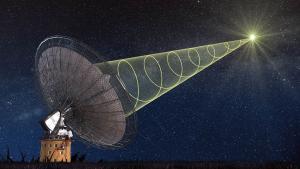Blog
That Escalated Quickly
19 January 2015
 Swinburne Astronomy Productions
Swinburne Astronomy ProductionsOne of the stranger phenomena in astronomy are fast radio bursts, or FRBs. These are bursts of radio energy that last for a fraction of a second, but are extraordinarily bright. They don’t repeat like radio pulsars, but instead just occur as a single burst. They are so bright and short that for a while it was thought that they were terrestrial in origin rather than astronomical. As we gathered more data, it became clear that these strange radio bursts were really from space. Now it seems we’ve observed FRBs in real time.
The results are being published in MNRAS, and they show an FRB originating from 5.5 billion light years away.1 The signal was detected by multiple telescopes within hours of the event, so it was possible to see if there was any “afterglow” or secondary emissions after the burst. They didn’t find any, which eliminates some models such as strange supernovae or gamma ray bursts from the list of possible sources. Right now one of the main ideas is that they are caused by large, rapidly spinning neutron stars that then collapse into black holes. To know for sure, we’ll need to observe FRBs at a range of frequencies.
For now we know it is very real, and very strange. But this is what often happens in science. What begins as a mystery leads to answers that point toward an even larger mystery.
Petroff, E., et al. “A real-time fast radio burst: polarization detection and multiwavelength follow-up.” Monthly Notices of the Royal Astronomical Society 447.1 (2015): 246-255. ↩︎